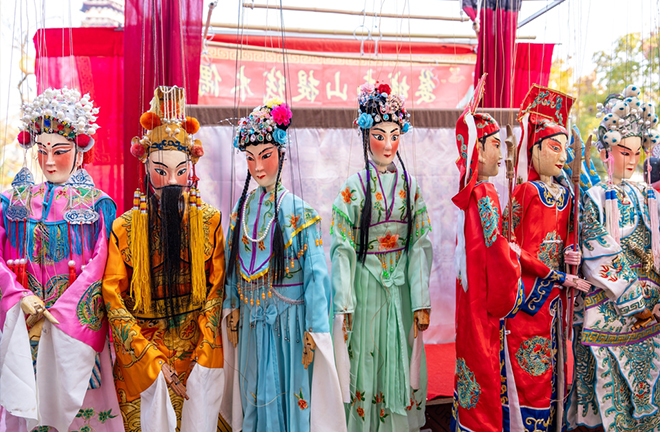Inheritance, preservation of intangible cultural heritage in new era

Puppet shows are among China's intangible cultural heritage. Photo: IC PHOTO
Intangible cultural heritage (hereinafter referred to as “ICH”) represents an important cultural symbol forged by a nation and its people over the course of history. At present, China has over 100,000 ICH items of various levels, including 1,557 featured on the national list. ICH embodies the legacy of the Chinese nation and constitutes a crucial vessel for showcasing the grandeur of Chinese civilization. However, China’s efforts to preserve and pass on ICH still face challenges such as weak systematic preservation, insufficient articulation of cultural value, and inadequate innovation in heritage transmission and dissemination. In the new era, the rapid development of digital technology brings new opportunities for ICH inheritance, preservation and innovation.
Digital preservation, inheritance
Digital technology enables the transformation of ICH into shareable and reproducible digital resources, ensuring precise and efficient preservation. For example, traditional crafts, music, dance, and opera can be digitally recorded, while physical artifacts can be virtually preserved through 3D and virtual reality (VR) applications. These tools address the fragility and loss risks inherent in traditional preservation methods, allowing ICH to transcend spatial and temporal limitations in its transmission and dissemination.
For certain endangered cultural heritage, digital technology offers new potential for restoration. Old materials can be restored to their original state, and even lost cultural heritage can be virtually reconstructed. Digital technology also provides platform support for ICH inheritance. Online courses, VR, and other tools allow broader public engagement with ICH, encouraging participation in education and practices, thereby facilitating its inheritance and development.
Despite these advances, uneven regional development remains a major challenge to the digital preservation of ICH. While developed regions lead in the deployment of digital technology, less developed areas often lack the resources and infrastructure necessary for effective ICH documentation and preservation. As a result, some invaluable skills risk being lost. Strengthening regional cooperation, fostering resource sharing and optimization, and promoting balanced development in ICH digital preservation are thus crucial priorities.
Contemporary value
The true value of ICH lies not only in the transmission of skills but also in its cultural spirit. Efforts to preserve and pass on ICH should focus on uncovering its symbolic implications to enable the contemporary reproduction of its cultural spirit. ICH elements can be blended with fashion, home decor, and architecture in ICH-inspired creative products, facilitating the integration of traditional craftsmanship into contemporary life. By preserving the essence of ICH while combining modern aesthetics and technology, we can produce more ICH-inspired creative products that meet contemporary needs, injecting new vitality into these traditions.
Although China boasts over 6,700 ICH workshops, the deeper exploration of its cultural essence faces persistent challenges. First, ICH is often deeply rooted in folk culture, with its inheritance and development relying on specific environments and contexts. With government support, sufficient funding, and widespread public interest, remarkable progress has been made in the preservation and development of national- and provincial-level ICH projects. In contrast, municipal- and county-level ICH projects are in decline, hindered by insufficient funding, the aging of skilled practitioners, the loss of traditional skills, and limited social awareness.
Second, as ICH is primarily passed on through oral tradition and mentorship, the lack of systematic documentation and organization impedes comprehensive ICH exploration and preservation.
Third, uncovering the cultural spirit of ICH requires expertise spanning multiple disciplines such as history, anthropology, and the arts. However, the cultivation and recruitment of interdisciplinary talent remains challenging, constraining the scope and depth of related efforts.
ICH encapsulates rich ethnic characteristics, regional customs, and historical memories, all of which are essential components of human civilization. Over the course of history, the Chinese nation has created a wealth of intangible cultural heritage, including opera, papercutting, and calligraphy, which not only embodies the wisdom and creativity of the Chinese people but also reflects their spiritual aspirations and values.
Today, ICH serves as both a unique symbol of national cultural identity and as a crucial bridge for civilizational exchange and mutual learning. Exhibitions, exchanges, interactions, and experiences in the realm of ICH allow people from diverse cultural backgrounds to connect with one another and appreciate the traditions and wisdom of others. In the new era, ICH inheritance and preservation is expected to be revitalized through the profound empowerment of digital technology. By translating its cultural essence into forms that resonate with contemporary life, ICH can effectively convey the spirit of Chinese culture on the global stage.
Wang Feng is an associate professor from the School of Art at Zhejiang International Studies University.
Edited by WANG YOURAN

 PRINT
PRINT CLOSE
CLOSE